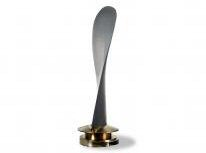
Airborne, headquartered in The Hague, claims this is the first time that composite materials have been used for a maritime main propeller of such power (about 1400 kW).
The propellers were delivered to the The Royal Netherlands Navy in September 2010. Test runs will start at the end of 2010 and will continue throughout 2011. The navy has 10 Alkmaar-class minehunters.
Erosion is a big problem in ship propellers made of bronze, explains Wiard Leenders, Managing Director of Airborne Composites:
“It interferes with the geometry of the blade surface, giving rise to turbulence and hence to vibration and noise. This effect on the acoustic signature of the vessels is particularly undesirable in minehunters, which have to operate very silently in order not to trigger the mines they are hunting. Frequent inspection and maintenance is the only way of ensuring a safe working environment in this case. The necessary maintenance is very expensive, and reduces the operational availability of these vessels. The use of composite materials for the ships’ propellers offers a way out of this impasse.”
Following promising results from hydrodynamic tests at MARIN (Maritime Research Institute Netherlands) in Wageningen, the Royal Netherlands Navy commissioned a follow-up study at Airborne. This focused on the possibility of producing propeller blades that adjust their position in response to the load on them. These propellers are quieter in use, and have a higher efficiency which may lead to fuel savings.
“These fuel savings have generated increasing interest in these ‘flexible’ composite propellers in civilian shipping circles,” Leenders says.
The composites used in the propeller are carbon fibre reinforced epoxy resin. Composite ship propellers have low magnetic, electrical and acoustic signatures. They require less maintenance, and have a longer operating life. The composites are less subject to corrosion and, as a result, the surface of the propeller remains smooth and there is less (noisy) cavitation. The production costs are also lower, because the mould can be used many times.
Airborne International develops composite products for antennas for astronomical radio telescopes, and for aerospace, maritime, and offshore oil and gas applications. In August, Airborne received €9 million from Holland Private Equity to fund a plant for the continuous production of thermoplastic composite pipes for the oil and gas industry.




